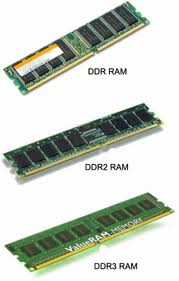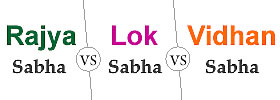Difference between DDR, DDR2 and DDR3 RAM
Key Difference: DDR (DDR1), DDR2 and DDR3 are different types of SDRAM that are used in computers. DDR2 provides a faster transfer rate, bus clock and is more power-friendly compared to DDR1. DDR3 is an advanced version of the same technology. It enables faster bus speeds and higher peak throughput than earlier memory technologies. All three memories differ in various contexts like technical and physical specifications.
RAM or random access memory is an important part of a computer as it serves the role of a short term memory. The memory provides the facility to store the data on a temporary basis. RAM is versatile in terms of versions and speeds. One needs to understand the difference between the various types of RAM, otherwise the compatibility issues may arise between the computer and the RAM.
 DDR stands for Double Data Rate. DDR RAM enables two data transfer per clock cycle. DDR, DDR2 and DDR3 are different versions based on the same DDR technology. The design of all three RAMs is based on Synchronous Dynamic Random Access Memory. DDR is also known as double pumped, dual-pumped and double transition process.
DDR stands for Double Data Rate. DDR RAM enables two data transfer per clock cycle. DDR, DDR2 and DDR3 are different versions based on the same DDR technology. The design of all three RAMs is based on Synchronous Dynamic Random Access Memory. DDR is also known as double pumped, dual-pumped and double transition process.
DDR or DDR1 falls in the category of first generation evolving from the SDRAM technology. The enhancements of prefetching, double transition clocking, strobe based data bus, and Stub-Series Terminated Logic_2 (SSTL_2) low-voltage signaling, etc. were made in the original technology to create DDR1.
DDR2 falls in the second generation and can be seen as a successor to DDR1. It is capable of providing data rates upto 6.4 GB/s. It is known for providing lower consumption in comparison to DDR1. Due to faster clocks, 1.8-V operation and signaling, along with a simplified command set, DDR2 has improved performance over its predecessor.
DDR3 (third generation of DDR SDRAM) is a further improved version of DDR2. It has specifically improved in bandwidth and power consumption. DDR3 operates at clock rates from 400 MHz to 1066 MHz with theoretical peak bandwidths ranging from 6.40 GB/s to 17 GB/s. The DDR3 standard allows chip capacities of 512 megabits to 16 gigabits.
DDR1 has become obsolete, therefore it is not produced in a massive scale today. DDR2 and DDR3 are being preferred for better performances.
Comparison between DDR, DDR2 and DDR3 RAM:
|
|
DDR RAM |
DDR2 RAM |
DDR3 RAM |
|
Full Form |
Double Data Rate 1 Random Access Memory |
Double Data Rate 2 Random Access Memory |
Double Data Rate 3 Random Access Memory |
|
Maximum Theoretical Transfer Rate (MB/s) |
DDR200 -1600 DDR266 - 2133 DDR333 - 2666 DDR400 - 3200
|
DDR2(400) - 3200 DDR2(533) – 4266 DDR2(667) - 5333 DDR2 (800) – 6400 DDR2(1066) - 8533 |
DDR3(800) - 6400 DDR3(1066) – 8500 DDR3(1333) - 10666 DDR3(1600) – 12800
|
|
Bus Speed (MHz) |
DDR200 -100 DDR266 - 133 DDR333 - 166 DDR400 - 200
|
DDR2(400) - 200 DDR2(533) – 266 DDR2(667) - 333 DDR2 (800) – 400 |
DDR3(800) - 400 DDR3(1066) – 533 DDR3(1333) - 667 DDR3(1600) – 800 |
|
Voltage |
Operates at comparatively highest voltage. |
Lower in comparison to DDR and higher in comparison to DDR3. |
Operates at comparatively lowest voltage. |
|
Typical Latency |
3 |
5 |
7 |
|
Number of Pins |
184 |
240 |
240 |
|
Features |
|
|
|
|
Packaging |
Thin small-outline package |
Ball Grid Array |
Ball Grid Array |
|
Succeeded by |
DDR2 |
DDR3 |
DDR4 |
|
Data Strobes |
Single-ended |
Single-ended or differential |
Differential only |
|
Modules |
184-pin DIMM unbuffered registered; 200-pin SODIMM; 172-pin MicroDIMM |
240-pin DIMM unbuffered registered; 200-pin SODIMM; 214-pin MicroDIMM |
240-pin DIMM (same size as DDR2 but are electrically incompatible with DDR2 DIMMs and have a different key notch location). DDR3 SO-DIMMs have 204 pins. |
|
Prefetch Buffer (bits) |
2 |
4 |
8 |
Image Courtesy: brogels.com









Comments
sabin shankhi
Tue, 11/28/2017 - 19:59
Add new comment